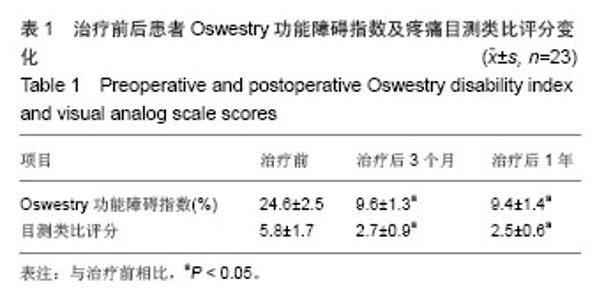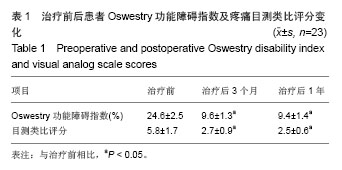| 1]邱贵兴,戴尅戎.骨科手术学[M].3版.北京:人民卫生出版社,2012.
[2]范里,杨波,徐勇,等.MASTTM QUADRANTTM可扩张通道管系统与椎间盘镜治疗腰椎间盘突出症的临床分析[J].中国现代手术学杂志,2012,16(2):122-125.
[3]王志荣,陆爱清,杨惠林,等.Quadrant通道下TLIF术治疗复发性腰椎间盘突出症的疗效分析[J].中国脊柱脊髓杂志,2014, 24(2): 121-126.
[4]Kinl KT,Lee SH,Suk KS,et al.The quantitative analysis of tissue injury markers after mini-open lumbar fusion.Spine. 2006;31(6):712-716.
[5]Ghahrenlan A,Ferch RD,Ra PJ,et al.Minimal access versus open posterior lumbar interbody fusion in the treatment of spondylolisthesis.Neurosugery. 2010;66(2):296-304.
[6]Suk SI, Lee CK, Kim WJ, et al. Adding posterior lumbar interbody fusion to pedicle screw fixation and posterolateral fusion after decompression in spondylolytic spondylolisthesis. Spine. 1997;22(2): 210-219.
[7]Rihn JA, Gandhi SD. Disc space preparation in transforaminal lumbar interbody fusion: a comparison of minimally invasive and open approaches. Clin Orthop Relat Res. 2014;472(6): 1800-1805.
[8]Ghahrenlan A,Ferch RD,Rao PJ,et al.Minimal access versus open posterior lumbar interbody fusion in the treatment of spondylolisthesis. Neurosurgery. 2010;66(2):296-304.
[9]王银,陈根元,胡龙, 等.开放与微创经椎间孔椎体间融合治疗单节段退行性腰椎疾病的Meta分析[J].中国组织工程研究,2013, 17(13):2415-2422.
[10]Park Y, Ha JW.The effect of a radiographic solid fusion on clinical outcomes after minimally invasive transforaminal lumbar interbody fusion. Spine. 2011;11(3): 205-212.
[11]黎庆初,胡辉林,刘宝戈, 等.多裂肌间隙入路微创手术治疗腰椎滑脱症[J].中国脊柱脊髓杂志,2011,21(4):303-307.
[12]邵诗泽,张恩忠,付松, 等.腰骶段多裂肌的形态特点及功能意义[J].中国临床解剖学杂志,2010,28(1):17-19.
[13]桂柯科,俞永林,赵明东, 等.中国人Wiltse椎旁肌间隙入路的观察与测量[J].中国组织工程研究,2014,18(22):3504-3509.
[14]王贵清,蔡显义,汤勇智, 等.Quadrant微创通道下单切口治疗腰椎间盘突出症伴节段不稳[J].中华临床医师杂志(电子版),2011, 5(11):3357-3359.
[15]贺石生.微创可扩张通道辅助腰椎融合术之管见[J].中华骨科杂志,2011,31(10):1022-1023.
[16]赵新建,谭家驹,廖绪强,等.腰椎滑脱的减压、内固定与融合术[J].中华骨科杂志,2002,22(2):72-75.
[17]王建,周跃,张正丰,等.微创经椎间孔腰椎体间融合术治疗腰椎滑脱症的临床研究[J].中华外科杂志,2011,49(22):1076-1080.
[18]刘红光,吴小涛,唐根林,等.通道下单侧椎体间减压融合内固定结合对侧经皮椎弓根螺钉内固定治疗腰椎退变性疾病[J].实用骨科杂志,2014,20(6):488-491.
[19]范顺武,方向前,赵兴,等.微创经椎间孔腰椎椎体间融合术治疗下腰椎疾病[J].中华骨科杂志,2007,27(2):81-85.
[20]Kim KT, Lee SH, Suk KS, et al. The quantitative analysis of tissue injury markers after mini-open lumbar fusion. Spine. 2006;31(6):712-716.
[21]Parker SL, Lerner J. Effect of minimally invasive technique on return to work and narcotic use following transforaminal lumbar inter-body fusion: a review.Prof Case Manag. 2012; 17(5):229-235.
[22]Perez-Cruet MJ, Hussain NS. Quality-of-life outcomes with minimally invasive transforaminal lumbar interbody fusion based on long-term analysis of 304 consecutive patients. Spine. 2014;39(3):191-198.
[23]颜登鲁,李健,高梁斌, 等.两种椎间植骨融合术治疗退行性腰椎滑脱症的疗效比较[J].中华外科杂志,2008,46(7):497-500. |

